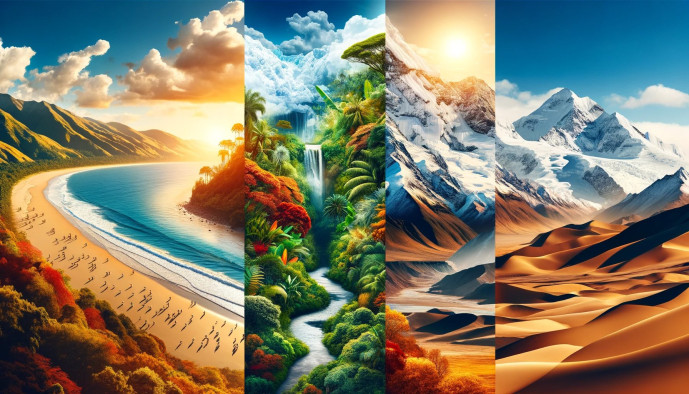Weather and Climate in Peru
Explore Peru's diverse climate zones, from coastal deserts to Andean peaks.

Essentials
Understanding Peru’s Three Climate Zones
Peru’s dramatic geography gives rise to three distinct climate zones, and it is very likely your itinerary will guide you through more than one. The country is broadly divided into:
- The Coast (La Costa): A slender desert strip running along the Pacific Ocean.
- The Highlands (La Sierra): The Andes mountain range that forms the country’s spine.
- The Jungle (La Selva): The immense Amazon rainforest sprawling across the east.
This diversity means you can easily experience intense equatorial sun, cold mountain nights, and humid rainforest heat all within a single journey. Preparing for these shifts by packing clothing that can be easily layered is absolutely essential for your comfort.
The Coast (Costa): Desert and Mist
Coastal Summer (December – March)
This period is characterized by hot, sunny, and often humid weather, marking the peak season for enjoying Peru’s coastline.
- Key Locations: Lima, Paracas, Máncora, Trujillo.
- Average Temperatures: 25-30°C (77-86°F).
- Notes: This is the ideal time for swimming and coastal excursions. Lima, in particular, is less affected by the persistent coastal fog, known as garúa, during these months.
Coastal Winter (April – November)
The weather becomes mild, cool, and generally overcast. While it rarely rains in a conventional sense, a persistent and damp sea mist called the garúa is common, especially in and around Lima.
- Key Locations: Lima, southern coast.
- Average Temperatures: 15-20°C (59-68°F).
- Notes: Though not suitable for sunbathing, this season offers perfectly comfortable conditions for city exploration and cultural tours. It is worth noting that the far northern coast, near Máncora, remains significantly sunnier year-round.
The Highlands (Sierra): Sun and Rain
Dry Season (April – October)
This season is defined by brilliantly clear, sunny days followed by cold, crisp nights. It is widely considered the best time for trekking and mountain exploration.
- Key Locations: Cusco, Sacred Valley, Machu Picchu, Huaraz, Lake Titicaca.
- Daytime Temperatures: 18-22°C (64-72°F).
- Nighttime Temperatures: Can drop to freezing, often between 0-5°C (32-41°F).
- Notes: Due to the high altitude, diligent sun protection is crucial. The temperature difference between being in direct sunlight and in the shade is significant and felt immediately.
Wet Season (November – March)
During the wet season, mornings are frequently clear and pleasant, with rainfall typically arriving in the afternoon. These downpours can be quite heavy but are often brief.
- Key Locations: Cusco, Sacred Valley, Machu Picchu.
- Average Temperatures: Similar to the dry season, but with noticeably higher humidity.
- Notes: The landscape becomes exceptionally lush and green. Please be aware that the Inca Trail is closed for maintenance each February. Travelers in remote areas should be prepared for potential travel delays caused by landslides.
The Amazon (Selva): Hot and Humid Year-Round
“Drier” Season (April – October)
The weather remains hot and humid with regular rainfall, but the showers are generally less frequent and not as intense as in the wet season.
- Key Locations: Iquitos, Puerto Maldonado, Manu National Park.
- Average Temperatures: 30-35°C (86-95°F).
- Notes: River levels are lower during this time, which exposes more jungle trails for exploration on foot. Mosquito activity is also slightly reduced.
Wet Season (November – March)
This period is marked by heavier and more frequent rainfall, often arriving in powerful afternoon bursts. Humidity is at its absolute peak.
- Key Locations: Iquitos, Puerto Maldonado.
- Average Temperatures: 28-33°C (82-91°F).
- Notes: The high river levels allow for more extensive exploration of smaller creeks and hidden waterways by boat. Wildlife can often be easier to spot along the newly formed riverbanks.
Microclimates and Altitude
Be Prepared for Anything: Peru is a land of countless microclimates. It is entirely possible for the weather at Machu Picchu to be completely different from the conditions in nearby Cusco on the very same day. A flexible approach is always best.
The Sun’s Intensity: The sun at high altitudes, such as in Cusco or at Lake Titicaca, is extremely strong, even on overcast days. A high-SPF sunscreen, a wide-brimmed hat, and quality sunglasses are non-negotiable items for your daypack.
Layering is Key: The most effective strategy for navigating Peru’s varied climates is to dress in layers that you can easily add or remove as conditions shift. This is the single most important piece of packing advice we can offer related to weather; a t-shirt, a fleece, and a waterproof shell will prepare you for nearly any situation.